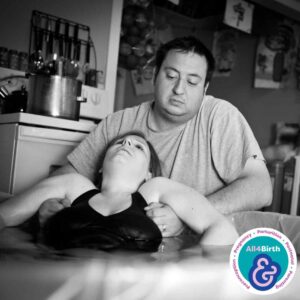Abbie Tomson
Midwife MSc, BSc, Yoga Teacher, Project Lead at All4Birth
@enevlorel
Summary
Labour can be an intense and challenging experience for many women, often accompanied by significant pain. While various pain relief methods are available, sterile water injections (SWI) have gained attention as a non-pharmacological option. This blog post will delve into the evidence supporting using sterile water injections during labour, drawing insights from the National Institute for Health and Care Excellence (NICE) guidance.
What are Sterile Water Injections and How do they work? 1

Sterile water injections involve the subcutaneous injection of small amounts of sterile water at specific points on the lower back. These injections aim to provide relief from back pain experienced during labour, particularly in the case of intense back pain associated with the posterior positioning of the baby’s head.
0.1ml to 0.5ml of water is injected into four injection points so they form small blisters under the skin. The injections are uncomfortable so they are usually given at the height of a contraction by two midwives simultaneously to reduce the feeling of the needles. The pain from the injection lasts about 30 seconds but after that, these injections might reduce the pain of contractions for two to three hours, with the greatest effect between 30 and 120 minutes. Injections can be repeated as often as required with no adverse effects (apart from the administration pain) on the mother or baby.
Theories around how they may work:
- The stimulus of sterile water injections might ‘shut the gate’ and prevent back pain or labour pain signals from reaching the brain.
- Work as a physiological distraction.
- Produces irritation in the skin, provoking changes in certain nerve fibres, which leads to endorphin release similar to that seen with acupuncture or TENS machines.
Evidence Supporting Sterile Water Injections:
Sterile water injections have been studied for their effectiveness in managing lower back pain during labour. Here are some key findings from various studies and reviews:
1. Systematic Review by Cochrane: This review included seven studies with 766 participants, focusing on the use of sterile water injections for labour-related low back pain. It found that SWIs significantly reduced pain compared to placebo, with about 50-60% of women reporting substantial pain relief. The review noted that there were no significant differences in the rates of caesarean sections, instrumental deliveries, or rescue analgesia between the SWI and placebo groups. Additionally, women treated with SWI were more likely to request the same analgesia in future labour. No adverse events other than transient pain at the injection site were reported. 2
2. The SATURN Trial Protocol: This ongoing randomized controlled trial aims further to investigate the efficacy of SWIs in labour pain management. The trial is designed to compare SWI with normal saline injections as a placebo, focusing on pain relief measured by the Visual Analogue Scale (VAS) and other outcomes such as subsequent analgesia use and patient satisfaction. 3
3. BMC Pregnancy and Childbirth Study: This study compared single versus multiple SWI techniques for continuous lower back pain during labour. It reported significant pain reduction within 30 minutes post-intervention for both techniques. Secondary outcomes included patient satisfaction, subsequent analgesia use, and the likelihood of using SWIs in future labours, showing positive responses overall. 4
4. Meta-Analysis in British Journal of Obstetrics and Gynecology: A systematic review and meta-analysis found that SWIs are effective in reducing labour pain. The analysis consolidated data from multiple trials, reinforcing the effectiveness and safety of SWIs for pain relief during labour. 5
Overall, these studies support the use of sterile water injections as a beneficial, low-risk method for managing lower back pain in labour. They highlight significant pain reduction, high patient satisfaction, and a strong likelihood of women choosing this method again in future labours. However, the studies also emphasise the need for more research to standardise methods and confirm long-term outcomes.
NICE Guidance on Sterile Water Injections: 1
Recommendation: NICE recommends
1.6.13 Consider intracutaneous or subcutaneous sterile water injections as a pain relief option for women in labour with back pain. These injections can be given by a midwife trained in the use of sterile water injections. [2023]
1.6.14 Explain to the woman that sterile water injections can provide relief of back pain from 10 minutes after the injection for up to 3 hours, but there can be an initial stinging sensation. [2023]
1.6.15 If the woman chooses to have sterile water injections, give these at 4 different injection points around the Rhombus of Michaelis, using doses of 0.1 ml intracutaneously or 0.5 ml subcutaneously at each injection point. [2023]
Conclusion
Sterile water injections offer a promising option for pain relief during labour, particularly for women experiencing back pain. The evidence suggests they can provide effective relief with minimal risk when administered by trained healthcare professionals. With NICE guidance supporting their consideration as a pain management option, sterile water injections contribute to the array of choices available to women during childbirth, empowering them to make informed decisions about their care. As with any medical intervention, healthcare providers must assess each woman’s needs and preferences to ensure the best possible outcomes during labour and childbirth.
Links to other resources
 Websites and Guidelines
Websites and Guidelines
References
- National Institute for Health and Care Excellence: Intrapartum Care
- Derry S, Straube S, Moore RA, Hancock H, Collins SL. Intracutaneous or subcutaneous sterile water injection compared with blinded controls for pain management in labour. Cochrane Database of Systematic Reviews 2012, Issue 1. Art. No.: CD009107. DOI: 10.1002/14651858.CD009107.pub2
- Lee, N., Gao, Y., Mårtensson, L.B. et al. Sterile water injections for relief of labour pain (the SATURN trial): study protocol for a randomised controlled trial. Trials 23, 155 (2022). https://doi.org/10.1186/s13063-022-06093-3
- Lee, N., Coxeter, P., Beckmann, M. et al. A randomised non-inferiority controlled trial of a single versus a four intradermal sterile water injection technique for relief of continuous lower back pain during labour. BMC Pregnancy Childbirth 11, 21 (2011). https://doi.org/10.1186/1471-2393-11-21
- Hutton, E. K., Kasperink, M., Rutten, M., Reitsma, A., & Wainman, B. (2009). Sterile water injection for labour pain: a systematic review and meta-analysis of randomised controlled trials. BJOG : an international journal of obstetrics and gynaecology, 116(9), 1158–1166. https://doi.org/10.1111/j.1471-0528.2009.02221.x












